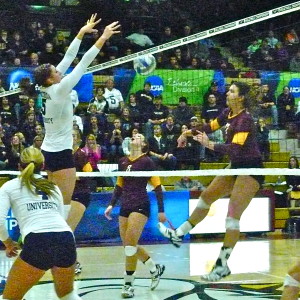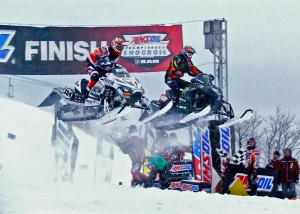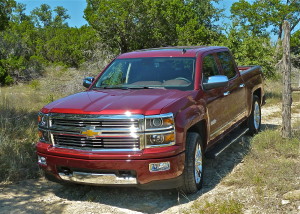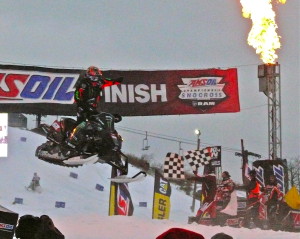Big 3 Again Big at Detroit Auto Show
Filed under: Equinox, Features, Autos
By John Gilbert
DETROIT, Mich. — Chevrolet became king of the “good ol’ boys” at the North American International Auto Show in Detroit by kicking off media preview days with the celebration of its biggest day ever.
Chevrolet swept both the 2014 North American Car of the Year with the restyled Corvette and North American Truck/Utility of the Year with the revitalized Silverado. While electric cars, hybrids, and ultra-high-gas-mileage technology filled Cobo Hall with a sea of advanced engine technology, the awards were swept by two Chevy stalwarts — with nary an overhead camshaft found amid any engines available in either of the two vehicles — as the Corvette and Silverado won the hearts of tradition-bound selectors.
The car and truck announcements, voted on by 49 independent media types, kicked off the early morning start to two days of media presentations for a reported 5,169 automotive writers, broadcasters and bloggers who converged on Motor City. Their presentation was immediately followed by a parade of what was reported as 50 vehicle unveilings, many of them worldwide introductions.
The resurgent “domestic” manufacturers of the traditional Detroit Big Three made strong showings, and even though the global marketplace blurs the lines, with numerous import brands made in the U.S., and more U.S. brands making their vehicles outside U.S. borders, the delineation continues, which at least allows for more convenient categorization: Read more
CLA250 Tops Price, Style Standards
Filed under: Weekly test drives, Autos
By John Gilbert
Amid the exhaustive competition for assorted 2014 Car of the Year awards, the Mercedes-Benz CLA250 will NOT win any of them. An objective and discerning person with the chance to test-drive one might be left with one obvious question: “Why not?”
From the standpoint of style, technology, driving pleasure, agility, comfort, and the astounding tandem of low sticker price and off-the-scale real-world fuel economy — a pair of attributes not usually mentioned with any Mercedes model — the CLA establishes some true benchmarks.
If someone suggested you could buy the best-looking sedan Mercedes ever produced, built on the first winter-beating front-wheel-drive sedan platform and capable of well over 30 miles per gallon for $50,000, you might be impressed. When you’re told it can be had for just a smidgeon over $30,000, you might knock over the salesman’s desk in your zeal to sign on the dotted line before such an obvious mistake could be corrected.
But it’s true. The Mercedes CLA250 starts at $30,000, and climbs only gradually with enticing stand-alone options instead of the usual costly package-price deals. True, you can get an AMG super-hot version for $50,000, and it is truly a world-class screamer. But why bother? Read more
Sports Home for Generation, Metrodome is No. 1
Filed under: Sports
By John Gilbert
As 2013 fades gently…make that frigidly into 2014, we are almost smothered by the sheer weight of stories and videos of media types telling us what the most important stories were during the past 12 months. It’s the same in sports, where everybody has an opinion of what the top sports stories of the year were.
This particular year, we had two of those conglomerate stories intertwine. Along with the biggest sports stories of 2013, there were all sorts of reminiscences by different sports columnists about the biggest games and events in the Metrodome’s 32-year history.
The Metrodome, located in downtown Minneapolis, ended its life when the Vikings finished their mostly miserable 2013 season with a surprising 14-13 victory over Detroit’s self-destructing Lions in a very entertaining December 29 game. It was entertaining, if meaningless, because the Lions had the division secured with seven games remaining, but lost six of those seven to pull despair out of the jaws of playoff success. And, of course, the Vikings had been out of contention since about Week 4 of a season that shall remain known for its quarterback roulette.
It is interesting, and a little amusing, to read all the insulting, denigrating comments about what a dump the Metrodome has been — mostly written by well-meaning folks who spent their years in the press box, whether at Met Stadium or the Metrodome, and had every possible creature comfort at their disposal. They have long ago lost the perspective of appreciative fans, who literally came in out of the cold when the Vikings, Twins, Gopher football and assorted state high school soccer and football teams, and assorted small college baseball teams found relief from the harsh weather to play indoors.
I had the chance to cover a number of major events in the Dome, including the deciding game the Twins Game 7 World Series triumph over St. Louis. I was there for quite a few other Twins games through the years, including the 1984 game when Dave Kingman, a huge left-handed slugger, hit a skyrocketing pop fly that went up and up and up toward the teflon ceiling — and then simply didn’t come down. The ball had, incredibly enough, gone into one of the small vent holes in one of the roof panels and disappeared. Kingman was awarded a double on the play, which is a pretty good reward for hitting a pop up, no matter how high.
I was also at the Dome when the command was given to take a knee to let the final seconds to run out the clock in the 1998 NFC championship game when the Vikings decided they were better off taking the Atlanta Falcons into overtime than in taking a shot at winning the game at the end of regulation. Atlanta promptly kicked the overtime field goal for for the conference title.
There were some problems with the Metrodome. The first one was tactical. When they decided to go with the inflatable teflon roof, it actually worked out amazingly well, even though it deflated from too much snow a time or two. But the decision to make the roof an off-white color was ridiculous, because what else in the sports world is an off-white color? If you guessed a baseball, you’d be right on. So every fly ball became an adventure for every outfielder, because as soon as the ball got higher than the seats, it became a vision test for every fielder.
It also meant that every pop fly seemed to disappear like Dave Kingman’s unique hit.
A fool might have decided to paint the ceiling a neat sky blue, as in the sky, rather than the exact color of a baseball. The other biggest problem was the first few years without air-conditioning, when the air inside during summertime seemed as artificial as the turf.
I also had the chance to play a couple of tournament games on that turf, one a “media” softball game, and the other an actual Over-35 baseball tournament, when I was recruited to play for a San Diego team. I made one great play from shortstop, when I darted to my left for a hard ground ball, with no real chance of reaching it, only to luck out when the topspin acquired on its first hop made it come up high on its second bounce — right into my glove. Those were memorable experiences, although they meant nothing in the overall picture of the place.
The Minneapolis Star Tribune did an impressive section pointing out all the biggest sports events held at the Dome through its lifespan. The reminiscing included numerous Twins happenings and Vikings events, and the Super Bowl and the two World Series, as well as state tournament games, basketball games, soccer games, and monster truck shows. When monster trucks were mentioned, I scoured the story for something, anything, on the series of Stadium SuperCross motorcycle races that ran there. I found nothing.
Working two blocks wesst of the Dome, I fought to cover the SuperCross. I had been covering motorsports along with hockey for most of three decades, and quite late in that time, I found that motocross racing, outdoors over bounding hills and jumps and obstacles, was very exciting, both for amateur and pro racers. During a couple of winters, I spotted some Stadium Supercross races on television. These were amazing events, with twisting, turning, hilly courses sculpted into off-road race courses through piles of dirt that had been trucked in.
In April of 1994, the Metrodome was selected as a site for one of the official season of Stadium Supercrosses. A young man named Jeremy McGrath had become a cult hero on television, so I suggested that this race would be worth covering on a Saturday night at the Metrodome. The suggestion was rejected. At that time, there was probably nobody else on our staff who had ever attended a motorsports event other than me. I reasoned that because of the television coverage, the event could draw a great crowd, maybe even 10,000 or 20,000 fans. The sports editor laughed out loud. Outrageous, he said.
So I went on my own, without any possibility of writing a story on it, and I was astounded to find the Metrodome was full — 47,000 fans — who hadn’t noticed the complete lack of publicity as they hustled to buy tickets and fill the place. The following Monday I mentioned that the crowd was, indeed, pretty good, and when I informed the sports editor what it was, he was properly impressed. It was the best crowd of that particular calendar year for any sports event in the state of Minnesota!
The next year, they let me cover it, and I shot a few photos of Jeremy McGrath flying over two or three jumps at a time, soaring above hard-working riders below, and doing gymnastic tricks on his motorcycle all the way. That’s become quite standard among some other top riders over the years, but back then, 20 years ago, McGrath was in a class of one who did such tricks and gave each one a nickname.
I wrote about the Supercross for the next few years, as it continued to sell out with advance tickets annually. In years when the Twins were mediocre and the Vikings were as well, the Supercross might have again been the largest crowd in the Dome for entire calendar years. My point is that it deserves a place on any list of the major events held in the Metrodome, but it’s difficult, if not impossible, to reminisce or recall any event, if you didn’t attend it.
Amid all the colorful recollections of all the games and concerts and extravaganzas held in the Metrodome, there is a star-crossed connection with the never-ending lists of the biggest sports stories of 2013 and the end of the Metrodome’s history, coinciding with the last Vikings game. In my mind, after housing so many memorable events, over so many years of being our state’s home sports facility, the biggest single sports story in Minnesota in 2013 is…the closing of the Metrodome.
UMD Gives Concordia Toughest Test
By John Gilbert
There might be better rivalries in collegiate sports than the one between Minnesota-Duluth and Concordia of St. Paul in women’s volleyball. But it’s hard to imagine one in Minnesota sports. The Concordia Golden Bears won an incredible seventh consecutive NCAA Division II volleyball championship in December, an honor they gained by wresting the Central Regional championship match from the Bulldogs in a four-game battle.
Expectations were high for UMD’s volleyball team, which earned the right to play host to the NCAA Division II Central Regional tournament by capping a fantastic season with a pair of victories over Concordia. First, UMD beat the Golden Bears in a five-game match to end the regular Northern Sun Intercollegiate Conference season.

Concordia’s Riley Hanson blocked a kill attempt by UMD’s Kate Lange, and her Bulldog teammate Ashley Hinsch reflected the despair.
The road got tougher when the Bulldogs had to win an NSIC playoff opener at home to reach the league playoff semifinals and final at Concordia, where the Golden Bears are virtually unbeatable. But the Bulldogs pulled it off, winning in the semifinals and then stunning Concordia in three straight games for the league playoff title.
Riding that hot streak that counted 10 consecutive games from the final regular season game through the three sweeps of the league playoffs, and that gave UMD the home court advantage as host to the Central Regional. Once there, UMD proved it belonged by sweeping past Arkansas Tech, then Southwest Minnesota State, while Concordia got back in the groove by beating Northern State and Central Missouri.
That put the Golden Bears into the Central Region final against UMD. At stake was a slot in the eight-team NCAA D-II tournament. UMD came in 33-2, having lost only an early match to Concordia at Concordia, and a late-season match against Northern State, while Concordia’s six-straight national championship streak was under siege, but the Golden Bears brought a 31-3 record into the match, with two of the three victories inflicted by the Bulldogs.
It figured to be a match of two of the nation’s best teams, because after No. 1 ranked Tampa, UMD was No. 2 and Concordia No. 3 — in the country, let alone the league or the region.
While UMD was loaded with power-hitting Kate Lange and a very strong supporting cast, Concordia has an incredibly balanced team, with every player seeming capable of every act required of volleyball specialists. Without question, the Golden Bears would be the constant, and it was up to the Bulldogs to return to the amazing peak they had attained in their two most recent battles with Concordia.
It was clear that Concordia was at its best, trading attacks with the Bulldogs from the start, and escaping with a 25-17 first game victory. It was 16-14 late in the game when the Golden Bears came up with a series of blocks that derailed the Bulldogs, running off five straight points to go from 16-14 to 21-14, and Concordia won a vital first game.
UMD stormed back in Game 2, with Lange at her best and her teammates rallying with her for a 25-20 victory. It was a tough game, standing 13-13 until Lange led a charge for four straight points, and a commanding lead. When it was 16-13, Lange, as powerful and explosive a hitter as there is in Division II volleyball, blasted one cannon shot that struck a Concordia player crouching down in the back row trying to block, and the ricochet shot off to the right and landed in Row 4.
It appeared that if the teams played evenly, the match would come down to how well Concordia could cope with Lange’s power. In Game 3, Concordia got the early lead but Lange got free to gain ties at 13-13 and 14-14. But then Concordia’s flawless hitting balance and skill gained four straight points, and the Golden Bears held firmly for a 25-21 triumph.
That put Concordia up 2-1, and UMD would have to win Game 4 in order to avoid the end of its season and force the final to a deciding fifth game.
Concordia ruined those plans by jumping ahead 5-1. From there, the game evolved into a mighty struggle for the Bulldogs to catch up, then fall behind, then catch up again. Trailing 10-5, UMD put on a stirring rally by winning six of the next seven points, with another Lange blast gaining an 11-11 deadlock. While it was far from a one-hitter charge, Lange rose above all for kills that also provided 12-1`2, 13-13, and 14-14 ties, and the Bulldogs also evened the game at 15-all. But then it was Concordia’s turn to score six of the next seven points, with a block point making it 21-16.
Game 4 wound up 25-20 for Concordia, making it the end of a splendid 33-3 UMD season, and the end of Lange’s record-shattering career — but not before she registered 24 kills in the title match — and sending the Golden Bears to their chance at a seventh consecutive national championship with a 32-3 record.
In the array of intercollegiate sports teams at UMD, volleyball falls in there someplace behind Division I men’s hockey, Division I women’s hockey, and Division II football, and in a lot of years it might find men’s and women’s basketball, baseball and softball battling it for “second tier” prominence.
But not this season. This season, football had a fantastic run to the national tournament’s second round, and men’s hockey is stirring up new interest in its new National Collegiate Hockey Conference. But women’s volleyball is right up there with the best and most entertaining sports on campus. When the current season just ended with a three games to one loss to six-time defending NCAA Division II Concordia of St. Paul, the Bulldogs had thoroughly entertained a crowd of 1,700 — win or lose. Of course, the Bulldogs won more than they lost, dropping only one home-court match at Romano Gym, to Northern State, before falling to Concordia.
UMD coach Jim Boos congratulated the Golden Bears, and his own team. “I’m proud of how hard we played,” he said. “We just got outplayed by a team that just played better. They made only nine hitting errors all night. I’m proud of our effort, and our energy level, and we had a tremendous year, with all the records and awards, but they just weren’t making any mistakes.”
Kate Lange, who set the all-time UMD record for career kills early in the season, finished with 24 kills on 59 attempts — both nearly twice as many as any other player on either team. “It was awesome to have all those fans behind us,” said Lange. “For sure, we battled back, and if we hadn’t dug such a hold for ourselves, we probably could have done even better.”
Lange got emotional then. “I kinda felt it was our night, until it was over,” she said. “It’s crazy it’s over already…I wouldn’t have played anywhere else.”
Concordia coach Brady Starkey is legendary for his casual approach. He has his team so plugged in that his players are always upbeat, never seeming to notice, or show, any effects of pressure. “Volleyball, and sports, are supposed to be fun,” said Starkey. “The games are much easier when everybody takes a light approach and is enjoying it.
“When they beat us 3-0, it was a good match. Our girls realized that if we don’t come to play in the final, what could happen. We played very efficient and clean and it was a total team effort. We got blocks when we needed them, we covered, we scrapped, and we got through some long rallies. We did a good job of taking what we could, and we got good touches to slow them down.”
Kayla Koenecke, a senior from Delano, has now played in — and won — regional and national championships every year. She’ll be trying for her fourth while the Golden Bears will be striving for their seventh. I asked he if she could ever envision Concordia losing in this Central Regional final. “No, I can’t ever envision that,” she said. “We enjoyed every point, because four years is too short, and you never know when you might have your last game together.”
Lange capped her senior season by being named first-team All-America, and then won the Division II volleyball player of the year award.
Hibbert Flies Past SnoCross Foes
By John Gilbert
It’s understandable pro snowcross racers aren’t satisfied when they lose, but Tucker Hibbert is the top pro snowmobile racer on the planet because he is more demanding than the normal racer. “I’m not always satisfied when I win,” Hibbert said at Spirit Mountain before last weekend’s AMSOIL Championship — the season-opening race on the 9-race 2013-14 schedule.
But after a slow start, Hibbert was definitely satisfied after sweeping both Pro Open feature races Saturday and Sunday. Not that it started out smoothly. Hibbert, who has won seven Snowcross championships but failed to win either last season or the season before at Spirit Mountain, went out on the creatively challenging jumps and hills carved into the top of Spirit Mountain and promptly had a problem in the match-race dominator competition Friday night. He came back to not only win Saturday night’s feature, but he lapped the entire field in the process.
On Sunday afternoon, with a large and enthusiastic crowd in the stands and spilling out of the chalet, Hibbert’s Arctic Cat was beaten off the starting surge by Kyle Pallin’s Polaris, and after they hopped, leaped and churned up the backside and came around the top of the course, Hibbert caught up. When they came past the finish line, Hibbert took the inside line and actually made the pass on Pallin as the two flew through the air and landed at the bottom turn.

There was a difference between the first and last laps of the AMSOIL SnoCross feature at Duluth’s Spirit Mountain. On the first lap, left, Tucker Hibbert made a flying pass of early leader Kyle Palliln; on the last lap, Hibbert was alone with the checkered flag.
From there, Hibbert made no mistakes, cruising to the victory that gave him a sweep of the weekend’s two Pro Open features and capped the weekend that also saw Pro Lites, Amateur, Women, and Junior Novice classes. The top two categories are the Pro Lites, for stock 600 cc. engines, and the Pro Open for modified, highly sophisticated 600s.
In Minnesota, Arctic Cats, which are made in Thief River Falls, and Polaris, which are made in Roseau, are the homestate favorites, but Canada’s Bombardier Ski-Doo machines, and the new Yamaha racers offer more competition. Hibbert, who now lives in Pelican Rapids, MN., grew up in Thief River Falls, and, naturally, has raced Arctic Cats since he started racing semi-pro, and turned to Pro in 2001.
“We have a 600 cc. two-stroke engine displacement limit, and Arctic Cat uses Suzuki engines,” said Hibbert. “We can make modifications to the oompression ratio and exhaust, and we make a lot of mods to the chassis and suspension.”
Year-round workouts, including motocross motorcycles in the summertime, keep riders like Hibbert in shape for the pounding they take on a course such as Spirit Mountain. The series is similar to NASCAR, where the season opens with the Daytona 500 — the biggest race of the season. The troupe moves to Blackjack Resort in Bessemer, Michigan, for the second race this weekend, then takes a break until the January 3-4 weekend at Canterbury Park in Shakopee.
An estimated 30,000 fans showed up for the three-day races. Among the colorful people who make Snowcross racing such an entertaining event are people like Rob Dahlen, who helps Tucker Hibbert and his brother and crew chief Kirk Hibbert with managerial duties. “When I was growing up in Thief River Falls, I raced a Polaris,” said Dahlen. “That didn’t go over too well and I got a lot of flak for being the only one on a Polaris when everybody else in Thief River Falls was on a green Arctic Cat. I was probably the first victim of bullying.”
Then there was Jake Scott, a rookie in the Pro Open category, who came to Minnesota a couple years ago and is now making the move up from Pro Lites as a teammate of veteran Levi LaValee on a Team LaValee Polaris. “I grew up on Long Island, and started racing snowmobiles when I was 13, in Vermont,” Scott said. “I did pretty well there, so I figured I’d come out west and see what it was like. It’s totally different; these guys are animals.”
Scott said it was his first time being interviewed. When asked how old he was, he said: “I’m 19, but I’ll be 20 in 10 months.”
Doing the math, that also means he’s just two months past being 18.
Asked if he works on the engines, Scott said: “No way. I wouldn’t ride anything I built!”
When his assessment was sought, and whether his mentor, Levi LaVallee, might be the favorite, Scott said: “That’d be great, but at this point, if I had to pick a favorite, it would have to be Tucker Hibbert.”
Quick learner, this rookie.
A week later, Hibbert swept both features at Bessemer, Michigan, as well, ending calendar 2013 by tying snocross legend Blair Morgan;s career record 84 victories. Hibbert opens 2014 at Canterbury Park in Shakopee, going for No. 85.






 John Gilbert is a lifetime Minnesotan and career journalist, specializing in cars and sports during and since spending 30 years at the Minneapolis Tribune, now the Star Tribune. More recently, he has continued translating the high-tech world of autos and sharing his passionate insights as a freelance writer/photographer/broadcaster. A member of the prestigious North American Car and Truck of the Year jury since 1993. John can be heard Monday-Friday from 9-11am on 610 KDAL(www.kdal610.com) on the "John Gilbert Show," and writes a column in the Duluth Reader.
John Gilbert is a lifetime Minnesotan and career journalist, specializing in cars and sports during and since spending 30 years at the Minneapolis Tribune, now the Star Tribune. More recently, he has continued translating the high-tech world of autos and sharing his passionate insights as a freelance writer/photographer/broadcaster. A member of the prestigious North American Car and Truck of the Year jury since 1993. John can be heard Monday-Friday from 9-11am on 610 KDAL(www.kdal610.com) on the "John Gilbert Show," and writes a column in the Duluth Reader.